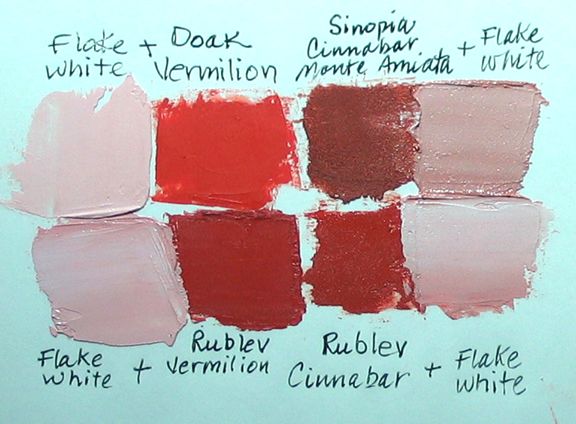top left: flake white + vermilion Robert Doak (tube)
top right: cinnabar Monte Amiata Italy Sinopia + flake white (dry pigment with linseed)
bottom left: flake white + vermilion Rublev Natural Pigments (dry pigment with linseed)
bottom right: cinnabar Rublev Natural Pigments + flake white (tube)
As you can see by these color samples, there is a marked difference between not only the pigments but the supplier. Robert Doak's tubed vermilion is much more brilliant than the Rublev brand which has a more earthy burnt quality. The Rublev cinnabar is redder than the Sinopia brand. To my eye, the Sinopia from Monte Amiata Italy has a very slight purplish tone. Each pigment is splendid in its own way, it just depends on the hue you need for the particular object or scene you are painting. I sometimes like a brighter color like the Doak vermilion, but also frequently use the more subtle natural cinnabar.
The red scarf below has mixtures of both cinnabar and vermilion depending on the placement of light and shadow areas.


Thanks for sharing this excellent color comparison. They validate my own samples and that is very valuable when dealing in rare stuff.
My vermilion from Robert Doak is identical. He has a right to his secrets but the brilliance of his vermilion made me wonder if he has enhanced it with something like a red 188. Then again, he has sources garnered over time that are unique. Usually, chemically pure mercuric sulphide, while a bright crimson powder, still looks a bit duller and more purplish, like the mineral cinnabar when ground in oil.
My wife lived in Shanghai for 5 years and speaks fluent Mandarin. Every time one of her friends returns, I try to coax them into finding some variety of ‘zhusha’ cinnabar but even when I write out the characters, it seems to be difficult to communicate. I’ll have to go on my own expedition someday.
Historically, China has produced many shades of cinnabar reds, grinding and processing them with glue sizings to extract the purer colors similar to extracting lapis and azurite as Cennini did.